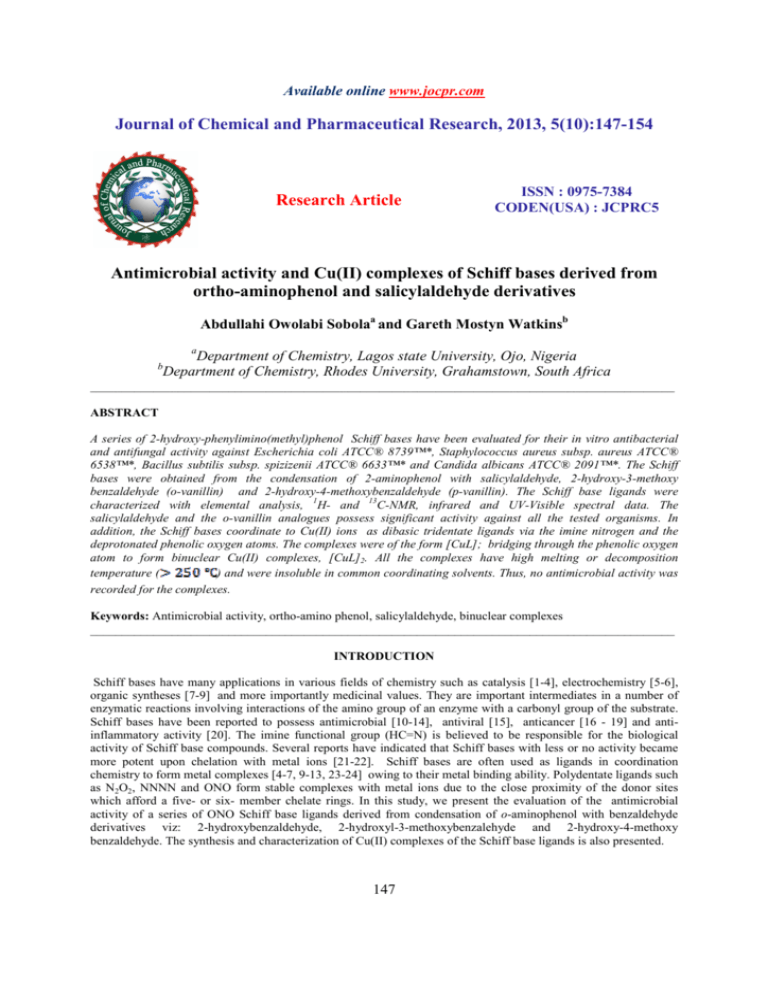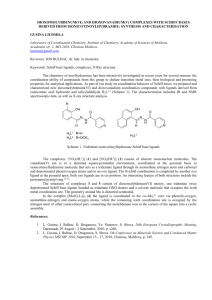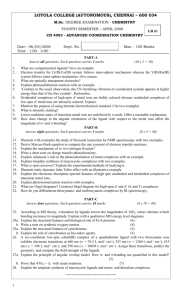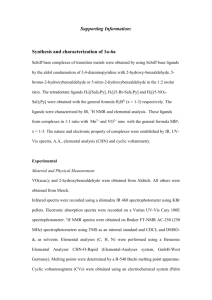Antimicrobial activity and Cu(II)
advertisement

Available online www.jocpr.com Journal of Chemical and Pharmaceutical Research, 2013, 5(10):147-154 Research Article ISSN : 0975-7384 CODEN(USA) : JCPRC5 Antimicrobial activity and Cu(II) complexes of Schiff bases derived from ortho-aminophenol and salicylaldehyde derivatives Abdullahi Owolabi Sobolaa and Gareth Mostyn Watkinsb a b Department of Chemistry, Lagos state University, Ojo, Nigeria Department of Chemistry, Rhodes University, Grahamstown, South Africa _____________________________________________________________________________________________ ABSTRACT A series of 2-hydroxy-phenylimino(methyl)phenol Schiff bases have been evaluated for their in vitro antibacterial and antifungal activity against Escherichia coli ATCC® 8739™*, Staphylococcus aureus subsp. aureus ATCC® 6538™*, Bacillus subtilis subsp. spizizenii ATCC® 6633™* and Candida albicans ATCC® 2091™*. The Schiff bases were obtained from the condensation of 2-aminophenol with salicylaldehyde, 2-hydroxy-3-methoxy benzaldehyde (o-vanillin) and 2-hydroxy-4-methoxybenzaldehyde (p-vanillin). The Schiff base ligands were characterized with elemental analysis, 1H- and 13C-NMR, infrared and UV-Visible spectral data. The salicylaldehyde and the o-vanillin analogues possess significant activity against all the tested organisms. In addition, the Schiff bases coordinate to Cu(II) ions as dibasic tridentate ligands via the imine nitrogen and the deprotonated phenolic oxygen atoms. The complexes were of the form [CuL]; bridging through the phenolic oxygen atom to form binuclear Cu(II) complexes, [CuL]2. All the complexes have high melting or decomposition temperature ( ) and were insoluble in common coordinating solvents. Thus, no antimicrobial activity was recorded for the complexes. Keywords: Antimicrobial activity, ortho-amino phenol, salicylaldehyde, binuclear complexes _____________________________________________________________________________________________ INTRODUCTION Schiff bases have many applications in various fields of chemistry such as catalysis [1-4], electrochemistry [5-6], organic syntheses [7-9] and more importantly medicinal values. They are important intermediates in a number of enzymatic reactions involving interactions of the amino group of an enzyme with a carbonyl group of the substrate. Schiff bases have been reported to possess antimicrobial [10-14], antiviral [15], anticancer [16 - 19] and antiinflammatory activity [20]. The imine functional group (HC=N) is believed to be responsible for the biological activity of Schiff base compounds. Several reports have indicated that Schiff bases with less or no activity became more potent upon chelation with metal ions [21-22]. Schiff bases are often used as ligands in coordination chemistry to form metal complexes [4-7, 9-13, 23-24] owing to their metal binding ability. Polydentate ligands such as N2O2, NNNN and ONO form stable complexes with metal ions due to the close proximity of the donor sites which afford a five- or six- member chelate rings. In this study, we present the evaluation of the antimicrobial activity of a series of ONO Schiff base ligands derived from condensation of o-aminophenol with benzaldehyde derivatives viz: 2-hydroxybenzaldehyde, 2-hydroxyl-3-methoxybenzalehyde and 2-hydroxy-4-methoxy benzaldehyde. The synthesis and characterization of Cu(II) complexes of the Schiff base ligands is also presented. 147 Abdullahi Owolabi Sobola and Gareth Mostyn Watkins J. Chem. Pharm. Res., 2013, 5(10):147-154 ______________________________________________________________________________ EXPERIMENTAL SECTION 2.1. Chemicals and instrumentation All the chemicals were of reagent grade (supplied by Sigma-Aldrich or Merck) and used as supplied. The 1H- and 13C- NMR spectra were recorded in deuterated DMSO-d6 with SiMe4 as internal standard on Bruker Avance NMR equipment operating at 400 MHz. The mid-infrared absorption frequencies (4000-700 cm-1) were recorded on a Perkin Elmer Spectrum 100 FT-IR equipped with universal attenuated total reflectance (ATR) accessory while the far-infrared (700-30 cm-1) spectra were recorded in nujol mull on a Perkin Elmer Spectrum 400 FT-IR. The UV/Visible spectra were obtained from PerkinElmer Lambda 25 spectrophotometer. The elemental analysis, CHN, was done on Vario MICRO V1.6.2 elemental analysen systeme GmbH while the percentage metal content was determined on PerkinElmer A Analyst atomic absorption spectrometer. The melting points (uncorrected) of the compounds were determined using Galenkemp melting point apparatus. The micro-organisms were purchased from Microbiologics (Cape Town, South Africa). 2.2. Synthesis of the Schiff base ligands The Schiff base ligands, L1 - L3 (sal-2-phen; ovan-2-phen; and pvan-2-phen) were synthesized according to the general synthetic procedure in the literature [4-7] by condensing salicylaldehyde, o-vanillin and p-vanillin with 2aminophenol respectively. The synthesized ligands are designated as sal-2-phen, ovan-2-phen, and pvan-2-phen, corresponding to ligands L1 - L3. 2.2.1. Ligand L1 (sal-2-phen) 1.07 mL (10.00 mmol) of salicylaldehyde was refluxed with 1.10 g (10.00 mmol) of 2-aminophenol in ethanol for 2 hr to obtain an orange solution. The solution was reduced under suction and an orange precipitate was obtained. The precipitate was filtered under suction, washed with ethanol and recrystallized from ethanol. It was dried over silical gel in a dessicator. Yield: 1.94 g (91%); δH (400 MHz, CDCl3) 13.78(1H, s, Ar-OH); 9.77(1H, s, Ar-OH); 8.97(1H, s, HC=N); 7.62(1H, d); 7.36(2H, dd); 7.25(1H, t); 7.06(2H, t); 6.93(1H, t). δC (400 MHz, CDCl3): 161.62(Ar-OH); 160.67(HC=N); 151.07(Ar-OH); 134.87(Ar-N=C); 132.78, 128.01, 119.54, 119.51, 119.44, 118.68, 116.63, 116.45(Ar-C); (Found: C, 73.01; H, 5.29; N, 6.44%. Cal. for C13H11NO: C, 73.23; H, 5.20; N, 6.57%). 2.2.2. Ligand L2 (ovan-2-phen) The procedure is the same as ligand L1 using o-vanillin and 2-aminophenol. A red precipitate was obtained. Yield: 2.40 g (97%); δH (400 MHz, CDCl3): 14.44(1H, s, Ar-OH); 9.79(1H, s, Ar-OH); 8.86(1H, s, HC=N); 7.46(1H, d); 7.36(1H, d); 7.18(1H, t); 6.92(2H, dd); 6.46(1H, d); 6.41(1H, t) and 3.80(3H, s, -OCH3). δC (400 MHz, CDCl3): 166.54(HC=N); 164.68(Ar-OCH3); 160.73(Ar-OH); ; 151.32(Ar-OH); 134.76(Ar-N=C); 128.20, 120.49, 119.85, 117.23, 113.87, 107.40, 101.91(Ar-C) and 56.24(-OCH3); (Found: C, 68.89; H, 5.43; N, 5.72%; Cal. for C14H13NO2: C, 69.12; H, 5.39; N, 5.76%). 2.2.3. Ligand L3 (pvan-2-phen) The procedure is the same as ligand L1 using p-vanillin and 2-aminophenol. A yellow precipitate was obtained. Yield: 2.20 g (91%); δH (400 MHz, CDCl3): 14.39(1H, s, Ar-OH); 8.84(1H, s, HC=N); 7.44(1H, d); 7.30(1H, d); 7.12(1H, t); 6.86(2H, dd); 6.45(1H, d); 6.40(1H, t) and 3.79(3H, s,-OCH3). δC (400 MHz, CDCl3): 162.36(HC=N); 152.12(Ar-OCH3); 148.96(Ar-N=C); 147.37(Ar-OH); 133.01(Ar-Br); 128.27, 128.14, 124.30, 119.00, 115.44(ArC), 56.57(-OCH3); (Found: C, 69.31; H, 5.45; N, 5.70%; Cal. for C15H15NO2: C, 69.12; H, 5.39; N, 5.76%). 2.3. SYNTHESIS OF THE COMPLEXES 0.123 g (0.617 mmol) of copper acetate monohydrate, Cu(OAc)2.H2O, was dissolved in 10 mL ethanol and added drop-wisely to a vigorously stirring 0.30 g (1.23 mmol) ethanolic solution of ligand L1. A green precipitate of the complex was obtained immediately. It was filtered under suction, washed thoroughly with ethanol and dried over silical gel in a desiccator. The same procedure was repeated for the other complexes. The physical and analytical data for the complexes are presented in table 1 below. 2.4. BIOLOGICAL STUDY The Schiff base ligands and their respective Cu(II) complexes were screened for their in vitro antibacterial and antifungal activity against Escherichia coli ATCC® 8739™*, Staphylococcus aureus subsp. aureus ATCC® 6538™*, Bacillus subtilis subsp. spizizenii ATCC® 6633™*and Candida albicans ATCC® 2091™*. 148 Abdullahi Owolabi Sobola and Gareth Mostyn Watkins J. Chem. Pharm. Res., 2013, 5(10):147-154 ______________________________________________________________________________ 2.4.1. DISC DIFFUSION TECHNIQUE The qualitative antimicrobial susceptibility testing of the compounds was evaluated using the disc diffusion technique [21]. Each test organism was inoculated onto a nutrient agar plate and incubated at 37 ◦C for 24 hrs to obtain the primary culture. Several discrete colonies were picked from the culture to make a bacterial suspension (10 mL) in a test tube using saline water. The turbidity of the suspension was compared with 0.5 Mc Farland standard to obtain 106-108 CFUs. The bacterial suspension (0.1 mL) was inoculated onto Mueller Hinton plate and the sterile discs that have been impregnated with the test compounds were firmly placed on it. The assay was inoculated at 37 ◦C for 16 hrs and the zone of inhibition was measured as millimeters diameter. Ampicillin and dimethylformamide (DMF) were used as standard antibacterial drug and control solvent respectively. The test was repeated two more times for those compounds that showed activity of more than 6.5 mm and their activity was recorded as average zone of inhibition in table 3. Similar procedure was repeated for the antifungal susceptibility testing of the compounds using potato disc assay and ketoconazole in place of Mueller Hinton agar and penicillin respectively. 2.4.2. MINIMUM INHIBITORY CONCENTRATION (MIC) The quantitative antimicrobial activity of the test compounds was evaluated using macro dilution broth method according to Clinical and Laboratory Standard Institute (formally NCCLS) [21]. Two-fold serial dilutions of the compounds were prepared in 96 micro wells plates using sterile nutrient broth as diluent. The plates were inoculated with 5 ɥL bacterial suspensions containing 106 - 108 CFUs and incubated at 37 ◦C for 16-18 hrs. The MIC value was defined as the lowest concentration of the compounds giving complete inhibition of visible growth. The MIC values for the compounds varied from 0.15625 mg/mL to 0.01221 mg/mL and the result is presented in table 4. RESULTS AND DISCUSSION The Schiff base ligands (L1 - L3) were prepared by condensing equimolar amount of 2-aminophenol with salicylaldehyde, o-vanillin and p-vanillin under reflux in absolute ethanol. The Cu(II) complexes were, however, synthesized using 1:2 molar ratio of the Schiff base ligands and the Cu(II) ions using copper(II) acetate monohydrate. Table1: Physical and analytical data for the complexes Complexes Colour %Yield M.Pt Molar mass [CuL1]2 [CuL2]2 [CuL3]2 Green Green Green 93 60 85 >250 >250 >250 274.78 304.81 304.81 %Found (Calculated) C H N 56.01 (56.82) 3.11 (3.30) 4.93 (5.10) 54.98 (55.17) 3.39 (3.64) 4.55 (4.60) 54.98 (55.17) 3.37 (3.64) 4.60 (4.60) N.B.: *ns = not soluble Cu 23.5 (23.13) 20.95 (20.85) 20.70 (20.85) ΛM (Ω-1 cm2 mol-1) *ns *ns *ns Table 2: Infrared and UV-Visible spectral data for the ligands and the complexes Compound L1 [CuL1]2 L2 [CuL2]2 L3 [CuL3]2 ѴOH (cm-1) 3134 - 1949 ------------3129 - 1952 ------------3158 - 2043 ѴC-H (cm-1) 3043 3058 3056 2971 3058 Ѵc=N (cm-1) 1626 1613 1626 1610 1624 1599 ѴC-O(cm-1) 1272, 1304 1341, 1379 1277, 1306 1355, 1317 1276, 1286 1357, 1304 ѴCu-N (cm-1) -----540 -----535 -------555 ѴCu-O(cm-1) ---------489 --------472 ----------475 λ(nm) 275, 334, 444 409, 676 280, 350, 450 435, 628 337, 421 421, 641 3.1. ELEMENTAL ANALYSIS RESULT The microanalysis results for the ligands tallied with the expected values, thus confirming the purity of the compounds. In addition, the values for the complexes (table 1) indicated a 1 : 1 ratio for the copper ion and the Schiff base ligand. Thus, the complexes were of the form [CuL], which must thus dimerize [22], to form a neutral four-coordinate Cu(II) complexes, [CuL]2. The dimerization is presumed to occur from bridging between the two Cu(II) centres via the deprotonated phenolic oxygen atoms as shown in figure 1. The molar conductance of the complexes could not be determined because of its non-solubility in common solvent, including DMSO. The insolubility of the Cu(II) complexes in common coordinating solvent together with high melting or decomposition temperature (greater than 250 °C) has been used to support the dimeric nature of the complexes [22]. 149 Abdullahi Owolabi Sobola and Gareth Mostyn Watkins J. Chem. Pharm. Res., 2013, 5(10):147-154 ______________________________________________________________________________ N Cu R' R O O R O O R' Cu N L1: R = H; R' = H; L2: R = OMe; R' = H; L3: R = H; R' = OMe Figure 1: Proposed structure for the complexes 3.2. NMR STUDIES The NMR spectral data for the ligands are presented in the experimental section. The Schiff base ligands exist in enol form; as indicated by the non-splitting of the methine proton (figure 2) and the appearance of the phenolic protons [23 - 25] . The phenolic hydroxyl proton in the aldehyde moiety of the ligands absorbed downfield as a broad singlet at 14.44 - 13.77 ppm; while the broad signal at 9.79 - 9.77 ppm was attributable to the hydroxyl proton of the ortho-aminophenol moiety. The broadness of the signals was due to a strong hydrogen bonding between the imine N and the hydroxyl protons. On the other hand, the azomethine proton, HC=N, appeared as a strong singlet at 8.97 - 8.85 ppm, which was corroborated by the 13C-NMR signal at 166.54 - 160.73 ppm. The purity of the ligands was indicated by the disappearance of the aldehyde and the amino protons; CHO (δ = 9 - 10 ppm) and NH2 (δ = 3 - 4 ppm); in the ligands spectra. All the aromatic protons were accounted for and absorbed at 6.50 - 7.50 ppm. Lastly, the signals at 3.80 ppm and 56.55 - 56.24 ppm (13C-NMR), correspond to the methoxyl protons of ligands L2 and L3 resulting from o-vanillin and p-vanillin respectively. 3.3. INFRARED STUDY The infrared spectral data for the ligands are presented in table 2. The mid-infrared spectra of the ligands exhibit a broad absorption band at 3134 - 1949 cm-1, corresponding to the hydroxyl protons of the Schiff base ligands. The broadness and the low frequency values indicate the existence of a strong intra-molecular hydrogen bonding between the O-H and the N-H groups [26 - 27]. This band, however, disappeared in the spectra of the complexes due to deprotonation and involvement of the oxygen atom in the coordination sphere. In addition, the phenolic C-O stretching vibration bands at 1277 - 1272 cm-1 and 1306 cm-1286 cm-1 were blue-shifted to 1341 - 1301 cm-1 and 1375 - 1355 cm-1 respectively, confirming the complexation via the phenolic oxygen atoms [28 - 30]. Likewise, the strong band at 1626 - 1624 cm-1 is attributed to the imine (C=N) functional group of the free ligands. The band redshifted, to 1613 - 1599 cm-1, in the complexes, indicating coordination through the imine nitrogen [29 - 30]. The ligands are therefore considered bidentate. The mode of coordination of the ligands was further substantiated by the appearance of two new bands at 555 - 535 cm-1 and 489 - 472 cm-1; in the far-infrared spectra of the complexes. These bands are assigned to ѴCu-N and ѴCu-O respectively [10, 29]. The discussion so far, thus suggest that the Schiff bases (L1 - L3) coordinate as dibasic tridentate ligands. 150 Abdullahi Owolabi Sobola and Gareth Mostyn Watkins J. Chem. Pharm. Res., 2013, 5(10):147-154 ______________________________________________________________________________ Figure 2: 1H-NMR spectrum for ligand L2 3.4. UV/VISIBLE STUDIES The electronic transition study of the free ligands was carried out in methanol. Three distinct bands were observed at 280 - 275 nm; 350 - 334 nm and 450 - 421 nm. The first two bands correspond to the π → π* and n → π * transitions of the azomethine chromophore [31 - 32] respectively. The absorption band at above 400 nm (450 - 421 nm) has been previously assigned to the keto-imine form of ortho - hydroxylsalicylaldimines in polar and non-polar solvents [31]. The tautomerism is thought to occur via an intramolecular (or intermolecular in protonic solvents) hydrogen transfer to the imine nitrogen. Figure 3: Electronic spectra for the Cu(II) complexes 151 Abdullahi Owolabi Sobola and Gareth Mostyn Watkins J. Chem. Pharm. Res., 2013, 5(10):147-154 ______________________________________________________________________________ In addition, the solid reflectance spectra of the complexes exhibit a single broad band (figure 3) typical of a distorted copper (II) system, at 676 - 628 nm. The band is attributable to the 2A1g - 2B1g transition characteristic of Cu(II) ion in a square planar geometry [33]. The shift of the absorption band to lower energy than expected for square planar geometry at 568 nm for square planar N,N'-ethylenebis(salicylideneimine) Copper(II) [34], may be due to the distortion of the square planar geometry towards tetrahedral [33]. The square planar geometry is achieved by the coordination of the Schiff base ligands (L1 - L3) as ONO dibasic tridentate via the imine N, and the deprotonated phenolic oxygen atoms with consequent bridging via one of the enolic oxygen as shown in figure 1. 3.5 ANTIMICROBIAL RESULTS The diameter of zone of inhibition and the MIC results for the Schiff bases are presented in tables 3 and 4 respectively. Ligands L1 and L2 are significantly active against all the tested microorganisms as shown in figure 4; with L2 being specifically more potent than the standard antifungal drug, ketoconazole. L3 is only active against Bacillus subtilis subsp. spizizenii, a non-pathogenic gram-positive bacteria, and Candida albicans. The least inhibition of microbial growth was observed with the Escherichia coli, possibly due to the presence of an outer protective layer called lipopolysaccharide. The outer layer provides additional fortification to the cell membrane; limiting the concentration of test compound streaming through the bacterial cell wall. Thus, gram negative bacteria are more resistant to antibiotic treatment compared to the gram positive bacteria as evident in this study. Table 3: Diameter of zone of inhibition (mm) for the Schiff base ligands (L1 - L3) L1 [CuL1]2 L2 [CuL2]2 L3 [CuL3]2 DMF (control) Ampicillin (antibacterial) Ketoconazole (antifungal) Gram Positive S. aureus B. Substilis 28 28 *ns *ns 25 21 *ns *ns 11 *ns *ns 52 38 Gram negative E. coli 12 *ns 14 *ns *ns 28 Fungus C. albicans 08 *ns 25 *ns 07 *ns 20 *ns: Not soluble Figure 4: MIC values (1 x 10-1 mg/mL) for the Schiff base ligands [L1 - L3] Compounds L1 L2 L3 S. aureus 3.9063 0.4883 - B. substilis 0.1221 0.1221 15.625 E. coli 3.9063 0.9766 - Figure 4: Antimicrobial activity of the Schiff base ligands [L1 - L3] 152 Abdullahi Owolabi Sobola and Gareth Mostyn Watkins J. Chem. Pharm. Res., 2013, 5(10):147-154 ______________________________________________________________________________ Chelation enhances the antimicrobial activity of free ligands as this reduces the polarity of the metal ions and consequently increases the lipophilicity of the free ligands. However, all the complexes are not soluble in DMSO nor DMF and thus their biological activity could not be evaluated. CONCLUSION The salicylaldehyde and the o-vanillin analogues of the free Schiff base ligands exhibit significant antimicrobial activity against the tested organisms. The p-vanillin derivative is virtually non-active. All the Schiff base compounds form chelates with Cu(II) ions as dibasic tridentate ligands (ONO) via the enolic oxygen atoms and the imine nitrogen. In addition, bridging through the enolic oxygen suggests a binuclear four- coordinate Cu(II) complexes. Acknowledgements We are grateful to the Department of Chemistry, Rhodes University South Africa, for providing the facilities for this study. REFERENCES [1] VB Sharma; SL Jain; B Sain, J. Mol. Catal. A: Chem., 2004, 219(1), 61-64. [2] RM Wang; CJ Hao; YP Wang; SB Li, J. Mol. Catal. A: Chem., 1999, 147(1-2), 173-178. [3] DI Carlo; M Mathew; K-K Gabriele; DJ Matthew; LJ Andrew, Eur. J. Inorg. Chem, 2013 (9), 1541-1554. [4] S Bhunora; J Mugo; A Bhaw-Luximon; S Mapolie; J Van Wyk; J Darkwa; E Nordlander, Appl. Organometal. Chem., 2011, 25, 133–145. [5] S Ershad; L Sagathforoush; G Karim-nezhad; S Kangari, Int. J. Electrochem. Sci., 2009, 4(6), 846-854. [6] PE Martínez; BN Martínez; CR de Barbarín, Adv. Technol. Mater. Mater. Process. J. 2006, 8(1), 41-48. [7] H. Tanaka; H. Dhimane; H. Fujita; Y. Ikemoto; S. Torii, Tetrahedron Lett., 1988, 29 (31), 3811-3814. [8] MJ Brown, Heterocycles, 1989, 29(11), 2225-2244. [9] IIMathews; H Manohar, Polyhedron, 1991, 10(23-24), 2851-28513. [10] V Reddy; N Patil; SD Angadi, E- J. Chem., 2008, 5(3), 577-583. [11] A Valent; M Melnik; D Hudecova; B Dudova; R Kivekas; MR Sundberg, Inorg. Chim. Acta, 2002, 340, 15-20. [12] B Samanta; J Chakraborty; CR Choudhury; SK Dey; DK Dey; SR Batten; P Jensen; GPA Yap; S Mitra, Struct. Chem., 2007, 18, 33–41. [13] AE Ṣabik; M Karabӧrk; G Ceyhan; M; Tümer; M. Diǧrak, Int. J. Inorg. Chem., 2012, 2012, 11 pages. [14] UI Singh; RKB Singh; WR Devi; CB Singh, J. Chem. Pharm. Res., 2012, 4(2), 1130-1135. [15] SP Singh; SK; Shukla; LP Awasthi, Current Science, 1983, 52(16), 766–769. [16] MP Sathisha; VK Revankar; KSR Pai, Metal-Based Drugs, 2008, 2008, 11 pages. [17] M Coluccia; A Nassi; A Boccarelli; D Giordano; N Cardellichio; D Locker; M Leng; M Sivo, FP Intini; G Natile, J. Inorg. Biochem., 1999, 77(1-2), 31–35. [18] MM Kandeel; SM Ali; EKA Abed ElALL; MA Abdelgawad; PF Lamie, J. Chem. Pharm. Res., 2012, 4(9), 4097- 4106. [19] F Arjmand; F Sayeed; M Muddassir, J. Photochem. and Photobiol. B: Biology, 2001, 103, 166–179. [20] S Bawa; S Kumar, Indian J. Chem. Sect. B: Org. Chem. Incl. Med. Chem., 2009, 48B(1), 142-145. [21] EA Elzahany; KH Hegab; SKH Khalil; NS Youssef, Aust J. Basic and Appl. Sci., 2008, 2(2), 210-220. [22] MS Islam; MA Farooque; MAK Bodruddoza; MA Mosaddik; MS Alam, Online J. Biol. Sc., 2001, 1(8), 711713. [23] KT Joshi; AM Pancholi; KS Pandya; AS Thakar, J. Chem. Pharm. Res., 2011 3(4), 741-749. [24] R Vijayaganthila; A Nirmala; CH Swanthy, J. Chem. Pharm. Res., 2011 3(3), 635-638. [25] A Wanger; in: R Schwalbe; L Steele-Moore; AC Goodwin (Eds.). Antimicrobial Susceptibility Testing Protocols, Taylor and Francis group, London, 2007; 6. [26] A Syamal; KS Kale, Transition Met. Chem., 1979, 4, 298-300. [27] GO Dudek; RH Holm, J. Am. Chem. Soc., 1961. 83, 3914. [28] G Yeap; S Ha; N Ishizawa; K Suda; P Boey; MW Kamil, J. Mol. Struct., 2003, 658(1-2), 87-99. [29] M Yildiz; Z Kilic; T Hokelek, J. Mol. Struct., 1998. 441(1), 1-10. [30] GC Percy; DA Thornton, J. Inorg. Nucl. Chem., 1973, 35, 2319-2327. [31] AW Baker; AT Shulgin, J. Am. Chem. Soc., 1959, 81, 1523-1529. [32] K Rathore; RKR Singh; HB Singh, E-J. Chem., 2010, 7(S1), S566-S572. [33] SA Abdel-Latif; HB Hassib; YM Issa, Spectrochim. Acta Part A, 2007, 67, 950–957. 153 Abdullahi Owolabi Sobola and Gareth Mostyn Watkins J. Chem. Pharm. Res., 2013, 5(10):147-154 ______________________________________________________________________________ [34] JE Kovacic, Spectrochim. Acta, 1967, 23A, 183-187. [35] Y Zhou; X Ye; F Xin; X Xin, Transition Met. Chem., 1999, 24, 118-120. [36] R Ramesh; S Maheswaran, J. Inorg. Biochem., 2003, 96, 457-462. [37] NH Al-Shaalan, Molecules, 2011, 16, 8629-8645) [38] F Lloret; M Mollar; J Faus; M Julve; I Castro, Inorg. Chim. Acta, 1991, 189(2), 195 - 206. 154






